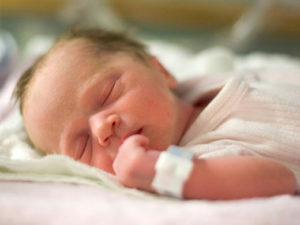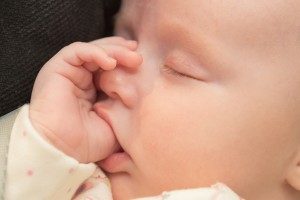 A while ago I posted the results of studies showing differences in infant microbiomes (community of microbes) depending on whether the babies were delivered vaginally or by C-section, and also that "vaginal seeding" may eliminate some of these differences. [C-section babies also have a higher incidence of some health issues, such as allergies, asthma, etc.] Well....that research generated a lot of controversy both for and against, and resulted in many women requesting that "vaginal seeding" be done to their babies after they were delivered by C-section. Even the noted microbiome researcher Rob Knight publicly admitted that the procedure was done to his baby after his partner received a C-section.
A while ago I posted the results of studies showing differences in infant microbiomes (community of microbes) depending on whether the babies were delivered vaginally or by C-section, and also that "vaginal seeding" may eliminate some of these differences. [C-section babies also have a higher incidence of some health issues, such as allergies, asthma, etc.] Well....that research generated a lot of controversy both for and against, and resulted in many women requesting that "vaginal seeding" be done to their babies after they were delivered by C-section. Even the noted microbiome researcher Rob Knight publicly admitted that the procedure was done to his baby after his partner received a C-section.
Vaginal seeding is the process of swabbing the bodies of C-section babies (including the mouth and nose) with a gauze pad containing the vaginal fluids from their mothers in the minutes after birth - so that the baby is exposed to the same maternal microbes as a baby born vaginally (because mothers transmit microbes to the baby as it moves through the birth canal). Initial research showed this made the microbiomes of the C-section babies look a lot like vaginally born babies, especially their skin and oral microbiomes, but whether these differences persist after a few months is unclear.
Now the American College of Obstetrics and Gynecology (ACOG) has come out with a position paper that vaginal seeding should not be done to babies, except as part of an official clinical trial. Their main opposition to the procedure is fear of transmitting pathogenic bacteria or viruses (e.g. group B streptococci, and STDs). The main reasons in support of doing the vaginal seeding procedure is the body of research finding differences among C-section and vaginally delivered babies (allergies, asthma, etc.), and the concern that at least some of this may be due to lack of exposure to maternal vaginal microbes during delivery. Instead, ACOG suggests breastfeeding the baby to transmit maternal microbes to the baby to "seed the gut". And if "a patient insists on performing the procedure herself, ACOG recommends ob-gyns have a documented discussion of the potential risks".
As can be expected, there is an outcry and rejection by some (many?) of the ACOG position paper. At least the ACOG paper acknowledges that every woman can make her own decision regarding this issue, even though they may not support it. And absolutely everyone agrees that more research is needed. From Ars Technica:
Doctors warn new parents: Step away from the vaginal fluid swabs
To slather, or not to slather—that is the question that has been roiling doctors, scientists, and new parents recently. And a new ruling by a doctor’s group stands to muck up the debate further. Amid the birth of microbiome research, some scientists have advocated for smearing bacteria-laden vaginal secretions on any newborns who missed out—namely those born via Caesarian section. Scientists keenly hypothesize that such a gooey glaze can “seed” a more-or-less sterile infant with life-long microbial companions. These wee chums may help train an infant's immune system and dodge issues like allergies and asthma later in life. Several studies have indeed found correlations between C-section deliveries and higher risks of those conditions.
In the latest turn to the controversy, the American College of Obstetricians and Gynecologists’ (ACOG) Committee on Obstetric Practice issued a November opinion firmly wiping up the slimy idea. In its opinion, the committee said it: “…does not recommend or encourage vaginal seeding outside of the context of an institutional review board-approved research protocol, and it is recommended that vaginal seeding otherwise not be performed until adequate data regarding the safety and benefit of the process become available.”
The few studies we do have on infant microbiomes provide no clear answers on the significance of an early “seeding” for health. A 2016 review looking at the patterns of microbial communities in the guts of infants in their first year found that C-section babies did show differences in the first three months. However, those differences disappeared by six months. Similarly, a small study of 18 babies also published last year found that vaginal seeding could eliminate microbial differences between vaginally and C-section delivered babies. But the study only looked at the infants' microbiomes in that first month, and the health effects—if any—are unknown.
The most concerning thing about vaginal seeding, the committee argues, is the potential for transmitting pathogens, such as herpes simplex virus, human papilloma virus (HPV), group B streptococci, and Neisseria gonorrhea. .... If a woman insists on the seeding, the committee recommended she be thoroughly tested and informed of the risks—as well as discouraged.
 Recent studies suggest that "vaginal seeding " of a newborn is effective and also has beneficial health effects for the baby. Vaginal seeding is transferring some of a mother's vaginal fluids (which contain beneficial microbes) onto newborns delivered via C-section.
Recent studies suggest that "vaginal seeding " of a newborn is effective and also has beneficial health effects for the baby. Vaginal seeding is transferring some of a mother's vaginal fluids (which contain beneficial microbes) onto newborns delivered via C-section.
 A while ago I posted the results of studies showing differences in infant microbiomes (community of microbes) depending on whether the babies were delivered
A while ago I posted the results of studies showing differences in infant microbiomes (community of microbes) depending on whether the babies were delivered